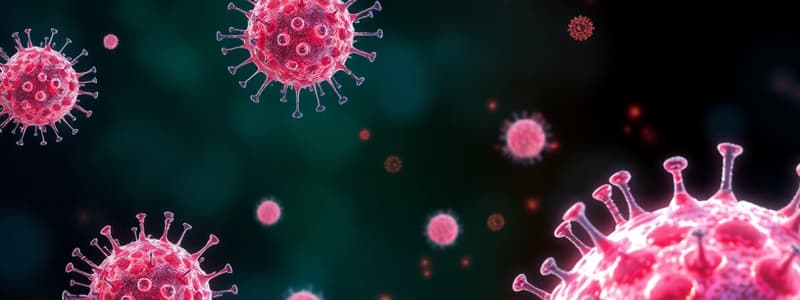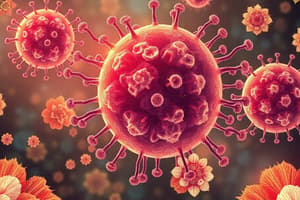Podcast
Questions and Answers
What is the primary function of IgM in the immune response?
What is the primary function of IgM in the immune response?
- Defense against parasites
- Crosses the placenta
- Primary immune response (correct)
- Opsonization
Which subclass of IgA is associated with mucosal sites?
Which subclass of IgA is associated with mucosal sites?
- IgA1 (correct)
- IgG1
- IgA2 (correct)
- IgE
What triggers the classical pathway of the complement system?
What triggers the classical pathway of the complement system?
- Serum proteins binding to mannose
- Bacterial endotoxins
- Spontaneous C3 breakdown
- Antigen-antibody complexes (correct)
Which IgG subclass is known for its ability to cross the blood-brain barrier?
Which IgG subclass is known for its ability to cross the blood-brain barrier?
What is one of the main functions of the complement system?
What is one of the main functions of the complement system?
Which immunoglobulin isotype is primarily produced in response to a high dose of antigen?
Which immunoglobulin isotype is primarily produced in response to a high dose of antigen?
What characterizes the duration of response to a low dose of antigen?
What characterizes the duration of response to a low dose of antigen?
Which type of heavy chain is associated with IgE immunoglobulin?
Which type of heavy chain is associated with IgE immunoglobulin?
Which cytokine is primarily produced by T regulatory cells to inhibit B and T lymphocytes?
Which cytokine is primarily produced by T regulatory cells to inhibit B and T lymphocytes?
What is the primary function of immunoglobulins in the immune response?
What is the primary function of immunoglobulins in the immune response?
What type of activation occurs without help from T helper cells?
What type of activation occurs without help from T helper cells?
Which molecules on B cells interact with T helper 2 cells during T-dependent activation?
Which molecules on B cells interact with T helper 2 cells during T-dependent activation?
What is produced and secreted by plasma cells during the primary immune response?
What is produced and secreted by plasma cells during the primary immune response?
How do memory B cells respond upon re-exposure to an antigen?
How do memory B cells respond upon re-exposure to an antigen?
Which cytokines are produced by T helper 2 cells to aid in B cell proliferation?
Which cytokines are produced by T helper 2 cells to aid in B cell proliferation?
Flashcards
B Cell Activation
B Cell Activation
The process by which B cells are stimulated to produce antibodies in response to an antigen.
T-independent Activation
T-independent Activation
B cell activation that occurs without T helper cell assistance, often by polysaccharide antigens.
T-dependent Activation
T-dependent Activation
B cell activation that requires help from T helper cells to respond to antigens.
Primary Immune Response
Primary Immune Response
Signup and view all the flashcards
Secondary Immune Response
Secondary Immune Response
Signup and view all the flashcards
Immunoglobulin Types
Immunoglobulin Types
Signup and view all the flashcards
Functions of Immunoglobulins
Functions of Immunoglobulins
Signup and view all the flashcards
Onset of Immune Response
Onset of Immune Response
Signup and view all the flashcards
Cytokines in Immune Response
Cytokines in Immune Response
Signup and view all the flashcards
Regulatory T Cells
Regulatory T Cells
Signup and view all the flashcards
IgM
IgM
Signup and view all the flashcards
IgA
IgA
Signup and view all the flashcards
IgG
IgG
Signup and view all the flashcards
Complement System
Complement System
Signup and view all the flashcards
Classical Pathway
Classical Pathway
Signup and view all the flashcards
Study Notes
B Cell Activation
- B cell activation occurs in two ways: T-independent and T-dependent.
- T-independent activation involves binding of polysaccharides to B cell receptors (surface IgD and IgM), and complement receptors (CD21, CD35). An example is Haemophilus influenzae B.
- In T-dependent activation, B cells bind to the antigen using B cell receptors (surface IgD & IgM).
- The B cell presents the antigen with MHC II complex to activate the CD4 T cells.
- CD80/86 molecule on B cells bind with CD28 on T helper 2 cell.
- CD40 molecule on B cells bind with CD40L on T helper 2 cell.
Cytokines and B cell proliferation and differentiation
- T helper 2 cells produce IL-4, IL-5, IL-6 and IL-13.
- B cells proliferate and differentiate into B memory cells and plasma cells that produce and secrete IgM (primary immune response).
- On re-exposure, memory B cells rapidly differentiate into plasma cells producing more IgM, IgG, and IgA (secondary immune response).
Primary and Secondary Immune Responses
| Feature | Primary Immune Response | Secondary Immune Response |
|---|---|---|
| Ag exposure | First time | Second, third, fourth... |
| Ag dose | High | Low |
| Ig isotype | Mainly IgM | IgM, IgG, IgA |
| Onset | Delayed | Rapid |
| Duration of response | Short | Long |
Immunoglobulins (Antibodies)
- Immunoglobulins (Ig) are glycoproteins that mediate humoral immunity.
- They are produced by plasma cells and exist as membrane-bound immunoglobulins (IgM & BCR) and secreted immunoglobulins.
- There are five classes of immunoglobulins: three major classes (IgG, IgM, IgA) and two minor classes (IgD and IgE).
Immunoglobulin Structure
- Four polypeptide chains form a Y-shaped molecule held together by disulfide bonds.
- Two identical light chains, either kappa or lambda.
- Two identical heavy chains with one V domain (VH) and three or four C domains (CH1, CH2, CH3, and CH4).
- The VL and VH domains form a pocket that constitutes the antigen binding site.
Immunoglobulin Functions
- Block binding of microbes or toxins to cells.
- Opsonization and phagocytosis.
- Antibody-dependent cellular cytotoxicity (ADCC).
- Activation of the classical pathway of complement by IgG and IgM.
Complement System
- Circulating and membrane-associated proteins that function in both innate and adaptive immunity.
- Synthesized in the liver in an inactive form.
- Includes components C1 to C9 and factors B, D, & P.
Complement Pathways
- Classical pathway: Activated by antigen-antibody complexes (IgM & IgG).
- Mannan-binding lectin pathway: MBLs bind to specific mannose residues on microbes and activate MBL-activated serine proteases (MASP1 & MASP2).
- Alternative pathway: Bacterial endotoxin (LPS) directly produces spontaneous breakdown of C3 (C3a & C3b).
Complement Functions
- Complement-mediated lysis: The membrane attack complex (MAC) creates pores in cell membranes, inducing osmotic lysis.
- Opsonization and phagocytosis: C3b or C4b act as opsonins, enhancing phagocytosis by binding to microbes.
- Mediators of inflammation and chemo-attractants: C3a, C4a, and C5a act as mediators of inflammation and chemo-attractants to phagocytes.
Clinical Uses of Cytokines
- IL-2: Renal cell cancer and metastatic melanoma
- IL-11: Treatment of thrombocytopenia
- G-CSF: Bone marrow recovery from inhibition
- GM-CSF: Bone marrow recovery from inhibition
- Erythropoietin: Anemia with renal failure
Study Questions
- Classical complement pathway: Initiated by the formation of antigen-antibody complexes.
- Alternative complement pathway: Initiated by lipopolysaccharides (LPS) of Gram-negative bacteria.
Studying That Suits You
Use AI to generate personalized quizzes and flashcards to suit your learning preferences.




![Lecture 06: T-cells and B-cell activation [MCQ 2]](https://assets.quizgecko.com/cdn-cgi/image/width=300,height=200,fit=crop,quality=75,format=webp/quiz/3a994686d8bf59d60d02fc2aa264f493.jpg)